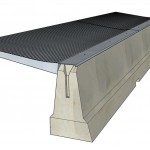Noise pollution can cause a lot of problems. It’s not just annoying, it can even lead to cardiovascular disorders. Esther from Soesterberg knows just how big a problem noise can be. For the past seven years she and her husband and three kids have lived on Amersfoortsestraat. That’s a provincial, four lane road where traffic rushes by at 80 kilometers an hour. To counteract the noise, in 2019 the province of Utrecht experimented with an innovative noise barrier called the Whiswall. And it was a success.
Esther explains what it’s like to live next to such a busy road. ‘Luckily it’s quiet at night. But I still can’t sleep with my window open, because the traffic would wake me up too early. We have to open the window in the bathroom, but that means we can barely hear each other during rush hour. And I can’t have a decent conversation with the neighbors in my front yard. We’d have to really shout.’
TRAFFIC NOTICEABLY LOUDER
So the sound is a definite issue, she says. ‘Although I’m not always aware of the noise. The brain tries to correct it. I mostly notice the silence in other places.’
Esther notes that the traffic has gotten noticeably louder during these past years of economic growth. ‘Until the moment I thought: this is too much, I can’t take it anymore! That’s when I approached the province to discuss the matter.’
INNOVATIEVE GELUIDSWAL
The province of Utrecht answered her call. That’s why from December 2018 until the summer of 2019, there was a Whiswall by the roadside. The Whiswall is an innovative steel and concrete noise barrier, about a meter and a half in height. The official results show the disturbance decreased significantly. Esther: ‘Yes, the design isn’t very pretty yet, but it does provide noise reduction. The first morning the wall was up, I was startled by how it felt. Even though the second floor bathroom is still noisy, it’s much nicer living here now. It’s also important to be able to see above the wall. That way you preserve a lovely view and social safety.’
‘I heard so much more nature during the trial!’
Esther
Esther is happy with the way the province handled the problem. ‘I’m glad the province engaged in conversation with us. We were informed at all the relevant moments during the trial. As residents, we were invited to several participatory evenings, as well as an evaluation at the end.’ Still, Esther does have a few remarks about the process. ‘I think it’s a shame some suggestions turned out not to be up for discussion. Lowering the maximum speed seems like a win-win to me, and raising the median would reduce the noise from the other side. Also, the official results were best-case scenario. Nonetheless, I’m very happy they’re placing the Whiswall.I expect it’ll only get better in the future, and new designs will blend in better with nature.’
PERMANENT PLACE ON AMERSFOORTSESTRAAT
In 2020 the Whiswall will be placed on Amersfoortsestraat permanently. The thought alone helps, Esther says. ‘Ever since I’ve known a change is coming, I’ve been able to endure the noise much better. I’m really looking forward to it!’
PART OF ENVIRONMENTAL NOISE ACTION PLAN
The provincie thinks it’s important that people who live near Utrecht’s provincial roads experience as little noise as possible. The Whiswall trial, along with other adjustments to lower noise pollution, is part of the province of Utrecht’s Environmental Noise Action Plan. With this plan, the province wants to maintain and improve the quality of the urban and rural environment. Curbing noise pollution contributes to this.




